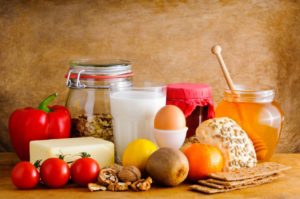
Defining Clean Eating
Clean eating is a deceptively simple concept. Rather than revolving around the idea of ingesting more or less of specific things (for instance, fewer calories or more protein), the idea is more about being mindful of the food’s pathway between its origin and your plate. At its simplest, clean eating is about eating whole foods, or “real” foods — those that are un- or minimally processed, refined, and handled, making them as close to their natural form as possible. However, modern food production has become so sophisticated that simply eating whole foods can be challenging these days.
What Counts as Processed Foods?
Additions of any kind — everything from salt, sugar, and fat to aid flavor and mouth feel, to preservatives that keep food from spoiling too quickly, to the vitamins enriching everything from beverages to breakfast cereal.
Changing the form of the natural food — for instance, removing the bran and germ from whole grains to create refined bread, mashing apples into applesauce, or stir-frying veggies.
Foods with components manufactured in a lab. (You probably don’t need clarification on this one, but if the ingredient list has stuff you can’t recognize or pronounce, that’s a pretty solid indication that it’s not natural).
In that light, processed food includes everything from a hot dog (where do we even begin?) to jarred organic pasta sauce and instant oatmeal. And yes, changing the form of natural food includes cooking as well, so even your steamed broccoli is technically processed, albeit minimally.
So why, exactly, is processing so bad — especially if it’s something as simple as adding heat?
Why Is Processed Food Bad?
Processing is not always bad. Often processing removes toxins or bacteria, or allows for us to eat certain types of foods in off-season due to freezing or canning. (Pasteurized milk, anyone?) Processing can also include altering the consistency or taste of food to make it more appealing. So that delicious post-workout kale-celery-spinach-banana smoothie you had? Enjoy that virtuous feeling knowing that you were likely able to down that giant amount of greens because your treat was somewhat processed.
Still, even though pasteurized milk, kale smoothies, and instant oatmeal are all processed, that doesn’t make them on par with doughnuts and Diet Coke.
The key is to avoid foods that are ‘ultra-processed — basically, anything food-product-like or ready-to-heat.”
The Problem with Ultra-Processed Foods
As you can probably guess, the health problems associated with ultra-processed food are numerous. Foods with genetically modified organisms (GMOs) have been linked to cancer and infertility; highly processed foods are stripped of nutrients needed for overall health; and heavily modified food tends to have additives that overstimulate the production of dopamine, the “pleasure” neurotransmitter, perpetuating a negative cycle of constant junk food cravings.
The Perks of Clean Eating
Thanks to extensive research that has linked eating whole foods with good health, we do know that largely plant-based diets are healthy. Multiple studies have shown that diets heavy on fruits and vegetables can curb or prevent certain life-threatening conditions and diseases, such as high blood pressure, type 2 diabetes, and cardiovascular disease. Plus, there’s research linking diets high in fruits and veggies to healthy weight management and glowing skin and hair — as if you needed more motivation.
How to Eat Clean
Unprocessed foods include:
- Fresh fruits and vegetables
- Dried legumes
- Nuts
- Farm-fresh eggs
Minimally processed foods include:
- Unrefined grains, like whole wheat bread and pasta, popcorn, steel-cut oatmeal, quinoa, and brown rice
- Frozen fruits and vegetables
- Unprocessed meat; wild over pastured, pastured over grain-fed
- Hormone-free dairy
- Oils
Pesticide-free organic food is preferable to avoid consuming added hormones or chemicals. It’s also important to note that eating clean doesn’t give you free reign to eat endless quantities. They may be healthy, but they still have calories!
You always have to think about portion size. I always encourage people to think of their plate in terms of fifths: three-fifths should be fruits and vegetables, one-fifth should be protein, and one-fifth healthy carbs.
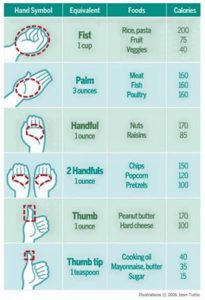
How to Shop Clean
Realistically, eating clean doesn’t mean you need to eat everything raw and straight from the ground. It means choosing minimally processed foods with few ingredients on the label, if it has a label at all.
If you’re shopping around the perimeter of the grocery store, that’s always a good start.
When perusing the main aisles for packaged foods, ask yourself:
- Where did this food or its ingredients come from?
- How much has it been processed or handled?
The ingredient label should be short, and all ingredients should be recognizable. Scan for easy-to-avoid additives like artificial coloring and flavors.
How to Cook Clean
Cooking does alter your food, but it isn’t necessarily a bad thing.
While it’s true that some nutrients are lost during cooking, like vitamin C, other nutrients are increased when foods are cooked, like lycopene, so it’s best to eat a wide variety of foods, in both their raw and cooked forms.
When cooking food, the focus should be on maintaining the integrity of what you are consuming and avoiding high-fat cooking methods such as deep-frying or stewing in animal or vegetable fats.
When cooking, opt for flash-cook methods such as stir-frying and ones without additives like steaming. For fruits and veggies, raw is best, but steaming is a close second in terms of preserving nutritional value and keeping the food’s natural integrity.
The Paleo Lifestyle
The Paleo diet, which promotes eating only foods as our ancestors did during the Paleolithic Era, is similar to a clean diet in that they both advocate whole foods. However, the Paleo diet limits food to pre-Industrial Revolution, meaning it prohibits all grains (not just refined ones), legumes, and dairy products, which clean eating does not.
The Whole 9 Lifestyle and Whole 30
Founded in 2009 by a couple in Texas, the Whole 9 lifestyle is based on nine principles that contribute to a balanced life. Nutrition is one of the core factors, and the lifestyle’s eating recommendation is one of whole foods, like meat, eggs, vegetables, fruit, healthy oils, nuts, and seeds.
If you’re new to Whole 9, it kicks off with a 30-day detox called Whole 30, in which whole foods are eaten but all alcohol, sugar, grains, legumes, and dairy are eliminated to push the reset button with your metabolism, systemic inflammation, and the downstream effects of the food choices you’ve been making.
If a brief, up to one week abstinence from certain foods — not all foods! — helps people get in the right mind-set to eat healthier, and they don’t have any medical conditions, then I think this is fine from a health and nutrition standpoint. However I don’t think it is necessary, and in many cases it sets people up for an ‘all or nothing’ approach to their diets.
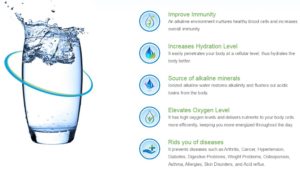
Breakfast Recipes:
OVERNIGHT OATS:
HOW TO MAKE OVERNIGHT OATS IN A JAR
Step 1: Take a glass or a bowl and add a serving of old fashioned rolled oats (basic porridge oats work a treat too). Fill the glass as much as you think you’ll be able to eat the next morning. (Tip: if you prepare the overnight oats in a sealable glass/jar then you can take it with you to work in case you still run out of time in the morning. No excuses! Pro tip: add 1 tbsp of chia seeds for some omega-3s and even more protein).
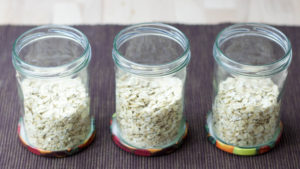
Step 2: Now fill up the glass with liquid until the oats are well covered. Possible liquids: milk, coconut milk, almond milk, rice milk, oat milk, orange juice. Whatever takes your fancy, really…
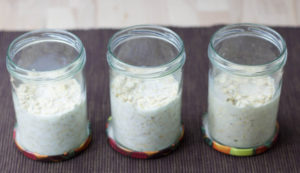
Step 3: It’s time to add your favorite toppings. Some ideas include: almonds, hazelnuts, walnuts, cashew nuts, flax seeds, chia seeds, raisins, all kinds of berries, fruits like banana, cherries, apples or pears, sunflower seeds, pumpkin seeds, nut butters, coconut flakes, greek yogurt, plain yogurt, the list goes on. If you like any of those suggestions with a little more crunch just add them in the morning.
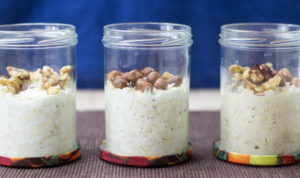
Step 4: Refine the overnight cereal with your favorite spices; for example cinnamon, vanilla, cocoa powder, ginger powder, gingerbread spice (perfect in winter!), all work really well.
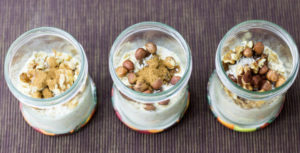
Step 5: Lid on top and off they hop to the fridge.
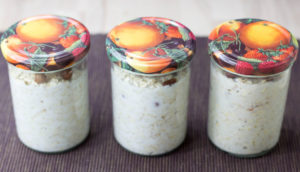
Basic Overnight Oats Recipe
Prep Time 5 minutes
Total Time 5 minutes
Servings 1
Ingredients:
- 1 clean jar with lid
- 1/2 cup rolled oats (1/2 cup = about half the jar)
- 1 cup milk (ex. almond milk)
- 2 tbsp nuts and/or seeds
- 1 tsp cinnamon (or other spices like cardamom or vanilla extract)
- 1-2 tsp your favorite sweetener
Optional:
- 2 tsp chia seeds
- Some slices of fruit (again, any are possible. Well, maybe not avocado. Or tomato.)
- All sorts of fresh or frozen berries
Instructions:
Throw everything in a jar, screw the lid on top, shake, and off it goes into the fridge. The next morning add a dash of milk and enjoy!
Banana Veggie Muffins
Yield: Makes 18 Muffins
Ingredients:
- 2 cups spelt flour
- 2 teaspoons baking soda
- ½ teaspoon salt
- 1 Tablespoon ground cinnamon
- 1/3 cup real maple syrup
- 1 teaspoon vanilla extract
- 3 ripe bananas
- 2 eggs
- 1 teaspoon rice vinegar
- ¼ unrefined coconut oil, melted
- ¾ cup carrots, finely shredded
- ¾ cup zucchini, finely shredded
- ¾ cup walnuts or pecans, coarsely chopped
Instructions:
- Preheat oven to 350.
- In a small bowl, combine spelt flour, baking soda, salt and cinnamon.
- In a food processor or blender, combine the maple syrup, vanilla extract, bananas, eggs, vinegar and oil.
- Transfer the mixture to a large bowl. Blend the dry mixture into the wet until thoroughly combined.
- Fold in the zucchini, carrots and nuts.
- Spoon the mixture into paper-lined muffin tins.
- Bake for 25-30 minutes or until a toothpick inserted in the middle of the muffin comes out clean.
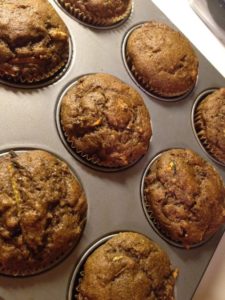



0 Comments